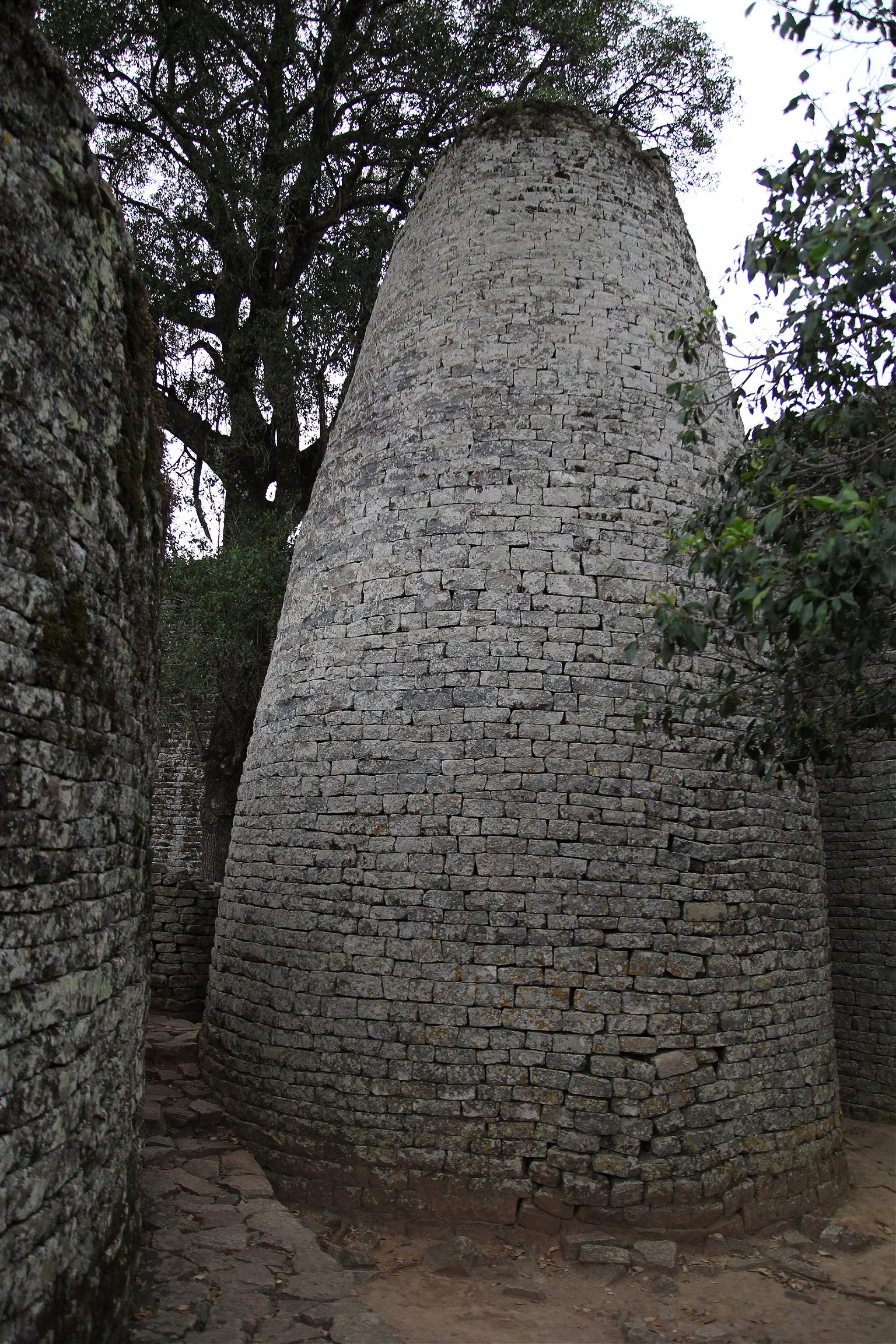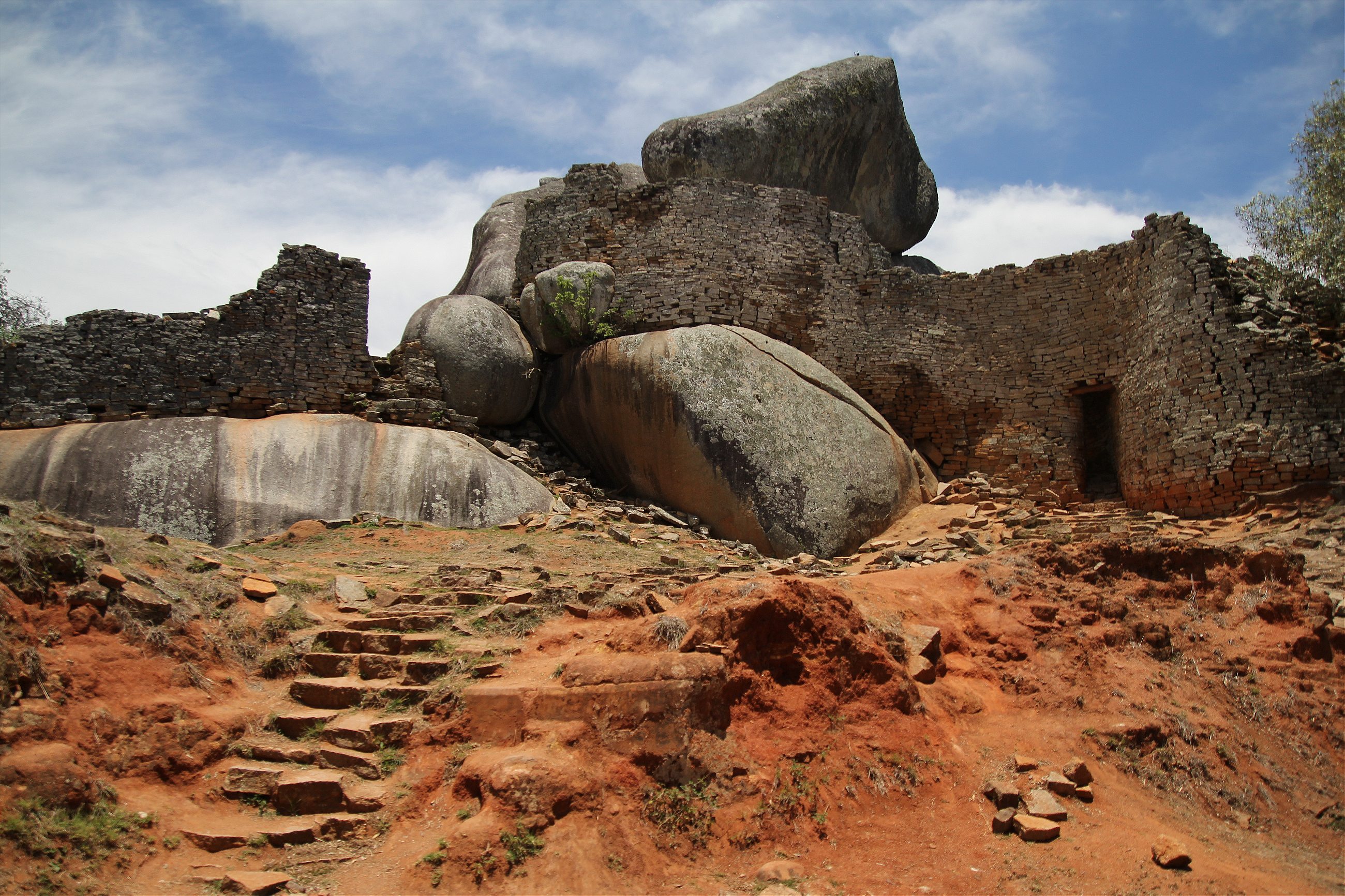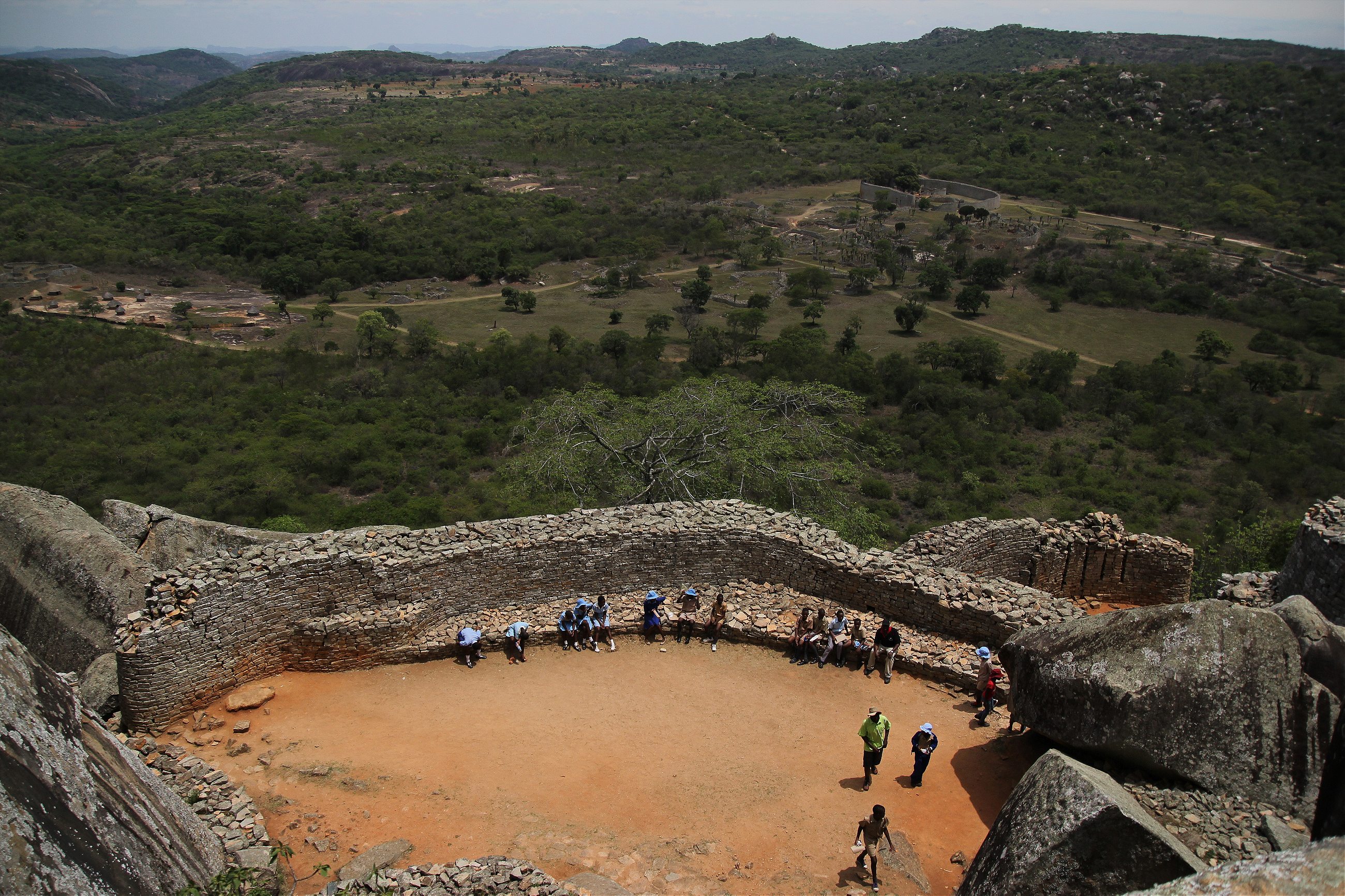A journey to the ruins of ancient Zimbabwe.
The road south out of Harare, the capital of Zimbabwe, is long and dusty. Our guide, Tsuri, drives my wife and I ever southward in the dawn light, before the African sun reaches its full power. We drive past reclaimed white farms and Shona villages and rounded kopje boulders (Dutch for “little head”) set amid maize fields, past rivers and thorn-clad acacias, past vervet monkeys sitting atop fence posts, past small girls offering honey for sale by the side of the road, past the steady stream of buses shuttling Zimbabwe’s diaspora workers home from South Africa.
Our goal is four hours away, an immense stone city once home to a line of powerful and wealthy kings. Great Zimbabwe, as the site is known, is the largest set of stone ruins in sub-Saharan Africa—so large and intricate that when Europeans first began archaeological investigation, they simply could not believe that the ancestors of the local Shona were the builders.
Instead, they revived a Portuguese legend about the biblical Queen of Sheba commissioning the city as a replica of the palace where she once stayed in Jerusalem. This story—backed by the German rediscoverer of the ruins, Karl Mauch—gained power, for the existence of the ruins was an inconvenient truth for Cecil Rhodes and his white-run colony of Rhodesia.
In 1980, when black rule was achieved after a guerrilla war, the new country looked first to these ruins as a symbol of historic pride and power and adopted its name for the new nation. Zimbabwe, in the Shona language, is a contraction of a phrase meaning “houses of stone.”

These days, the country is slowly recovering from the chaos of the early 2000s, when freedom fighter–turned-despot Robert Mugabe upended an entire society. The valueless Zimbabwean dollar has all but been removed in favor of the sturdier greenback. Starvation is rare now. And tourists are slowly returning.
Great Zimbabwe is set amid an arid landscape, all aloes and thorn trees and dust.
The rains are late this year. When this site was chosen, it was ideal for a rapidly emerging power. There was water and decent soil. There was granite and soapstone—vital for the building effort—and below that soil lay the glitter of gold. Though people had lived in the area since the third century, it was not until about the 11th century that the time was right. As Arab merchants moved southward down the Swahili Coast of East Africa, the kingdom of Zimbabwe grew wealthy through trade. Now it was time to build a capital.
Tsuri leads us through torrents of laughing schoolchildren pouring into their country’s top heritage site and up into the land of ancient kings. My wife points out the first sign of ruins: a high hill, wrapped in dry stone walling. Tsuri takes us on the ancient path upward, the path taken by generations of kings and underlings when they ruled this land. Halfway up, he stops abruptly.
“Here,” Tsuri proclaims. “Turn and see.” And behind us, invisible from below, lies the Great Enclosure, an immense stone circle in the distance that once housed the king’s family—his many wives, his children, his servants. The city itself covered 2.78 square miles. At its peak during the 14th and 15th centuries, the kingdom controlled more than 39,000 square miles.

The king himself lived high above his subjects, atop the hill we are climbing. Perhaps 20,000 Shona people lived here once—a large city, by the scale of the time. But the huts of common people were made of mud and logs, and they have returned to the soil. The kings too have gone. Only the work of their craftsmen remains: walls and fortifications built of granite blocks without the use of mortar.
For 300 years, this place was the site of immense wealth and regional power. Fully two-fifths of the world’s total mined gold came from this region during the 300-year rule of the kingdom of Zimbabwe. An estimated 600 tonnes of gold was mined here.
Ivory, too, was readily available. Soon, traders came in the thousands. Fragments of their wares have been found in the ruins: celadon ceramics from China, intricately painted faience pottery from Persia, Arabian glass, and European clothing.
Many traders came from the powerful Arab-African Swahili city-states of the east coast and shipped gold and ivory up to the Islamic heartlands. By the 16th century, the Portuguese too had arrived seeking gold. But Great Zimbabwe went into rapid decline and was abandoned later that century. The reason is still unclear. So too is the name of the people who founded Great Zimbabwe. All we know for certain is that they were from the Bantu language group.
Puffing, we reach the top of the hill and pass beneath a door with a thick granite mantel. I marvel at the strength of the design. Some walls here are 8 meters (26 feet) or more high, built without foundations. Epiphytes have moved in, and thick lichens cling to the walls. In places, baboons or humans have knocked down weaker walls. But much is still intact after 500 years of solitude. Walls weave in and around massive boulders.

These dry stone walls were made in remarkable fashion. Workers would heat large granite rocks in a fire before tossing water onto the red-hot rock. The shock of cold water cracked the granite into even, brick-shaped pieces. Millions upon millions of these were produced on the plains below and hauled up the hill, load by load. It took 30 years to build these walls alone, Tsuri says, and the city below was constantly being expanded. Workers placed each piece carefully in line with others, like a rock jigsaw.
Tsuri leads us deeper into the stone palace. From here, we can see Lake Mutirikwe, the largest natural lake in Zimbabwe. Here, the fish-eagle soared on powerful wings before diving like a stone to impale a fish. The bird’s strength made it the logical totem for Great Zimbabwe, and many stylized eagles were carved out of soapstone. Zimbabwe’s national flag bears the image of one of the soapstone eagles.
The original eagles lie in a musty museum below us, standing proud and tall. Even in the gloom of a small room, they have real power. Each bird seems to glow with fierce intensity. It was a long journey back from Europe, where collectors and museums eagerly snapped up these historic sculptures once sawn from their stone-column homes. The last known soapstone eagle returned in 2004.

“This place is remarkable,” I say to Tsuri when we stop for a breath. He grins and says, “You know, at first, white people said that no black could have done so. But they were wrong.” He leads us on into a cave shaped like a fish’s mouth. “Jane,” he booms suddenly, and the echo is surprisingly loud. “This is how the king communicated with his wives and servants below,” Tsuri says.
As we pass around another curve, the path suddenly opens out. From below, the hillside seemed unimpressive and the Great Enclosure far more formidable. But now, I can see why the king made his home here in the space above all things. For here is an amphitheater, with rock seating below a gargantuan slab of granite lodged between two peaks. One is shaped like an eagle, the beak glinting in the sun.
From here, the king presided over every important ritual—over the judgment of criminals, over the appeasing of ancestors, over sacrifice to rainmaker gods. “Let’s pretend to be the king,” says Tsuri, a twinkle in his eye. As we go up, a school group arrives, and dozens of joyous youngsters bear us upward on a tide of enthusiasm to the lookout, the place of kings.

From here, the great enclosure stands stark against the hills, and even the amphitheater below seems far away. Tsuri points to a raised platform below us. “That is where sacrifices of oxen were made. If their smoke went straight up, the ancestors were appeased. If it bent, they were unhappy and another sacrifice must be made. This was the place of religion. It was the home of the greatest of the fish-eagle icons.”
We give up the heights and head for the Great Enclosure below. Inside walls 10 meters (33 feet) high, a small forest has sprung up. The walls here are done with even more skill, for the stonemasons of old had gained skill after decades of constructing the hill palace. Passageways run tight and close through the ruins. Here, young royals were initiated into manhood or womanhood by their uncles and aunts. A centuries-old drainage system still works, funneling water outside.
Before long, we come to a conical tower, shaped like a large granary. The wives of kings lived here once. Now it is home to trees and visiting baboons.
Dusk is nearing, and we have a long drive back to Harare. As Tsuri takes us out onto the open road, he tells us of his life. Like many Zimbabweans, he was forced into exile during the bad years, desperately hunting work in Swaziland, in Zambia, in Malawi. His siblings still live outside the country. But our guide could not stay away forever. “To be an exile is lonely,” he says. “There is nowhere sweeter than home.” Perhaps someday soon, Zimbabwe will be on its path to greatness once more.View of the hilltop palace, where the seamless use of granite boulders and dry-stone walls can be seen.
